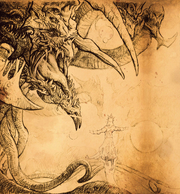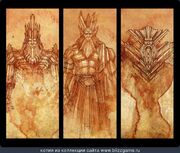Anu, according to legend, was the very first being in Creation. It was Anu who fought the battle with the Prime Evil Tathamet, their struggle leading to their deaths, but also the births of Heaven and Hell, angels and demons.
Biography
The Dawn

Anu battles Tathamet
It is written by the Skatsimi sage Lam Esen that in the beginning, there was but a single, perfect pearl, in which Anu resided. Anu was the sum of all things: good and evil, light and dark, physical and mystical, joy and sadness—all reflected across the crystalline facets of its form. And, within its eternal dream-state, Anu considered itself—all of its myriad facets. Seeking a state of total purity and perfection, Anu cast all evil from itself. All dissonance was gone...for a time. These discordant parts formed into the being Tathamet, the first Prime Evil. Though separate beings, Anu and Tathamet were bound within the pearl. There they warred against each other in an unending clash of light and shadow for ages uncounted, neither gaining the upper hand. At last, their energies spent after countless millennia of battle, they delivered their final blows. The energies unleashed by their impossible fury ignited an explosion of light and matter so vast and terrible that it birthed the very universe itself.[1]
Legacies
It is written that when it died, Anu transcended into a benevolent place beyond the universe, a paradise of which nothing is known. In the universe as it is known however, its legacy remained. The Eye of Anu, later known as the Worldstone, remained at the center of Creation as the foundation of all places, times, and possibilities. Anu's spine spun out into the primordial darkness, where it slowed and cooled. Over countless ages it formed into the Crystal Arch, around which the High Heavens took shape and form. It is from this arch that angels come into existence. The existence of Anu is known to some humans, though interpretations differ—some, especially in more primitive cultures, view the above tale as being absolutely true. Other scholars and mystics take the tale as being an elaborate metaphor for good and evil and the constant, warring dynamic seen among the forces of nature. Of note, to many scholars, archangels of the Angiris Council are living embodiments of the virtues of Anu. Though some aspects have changed for these angels, the beings Imperius, Tyrael, Auriel, Itherael, and Malthael represent(ed) Anu's virtues of valor, justice, hope, fate, and wisdom respectively.[1]
Some believe that Rogar's Huge Stone was fashioned from Anu's crystalized blood.[2]
Zoltun Kulle argued that it was humans, not angels, who were the true inheritors of Anu, for it was only when Anu rejected his darker half that true evil and suffering was born. In his mind, unlike Anu, humanity had to embrace its inner demons, and be all the stronger for it.[3]
In-game
The Oculus Ring makes reference to "the one god" in Diablo III. This is possibly a reference to Anu.
Anu is referenced in the flavor text of Rogar's Huge Stone.
Trivia

Artwork
- Anu is the sky-god and ruler of heaven in Sumerian and Babylonian mythology. He is also one of the oldest named divine beings in recorded history.
- In Old Norse, the word "Anu" is attested to mean "ancestor" or "forefather".
- In Gaelic Mythology, Anu is a Mother Goddess associated with fertility.
- The myth of Anu and the Dragon also bears certain similarities with that of Ahura Mazda, the Skyfather in Zoroastrian lore, such as the latter's primal enemy Ahriman emerging as a result of his purging his evil aspects, or having children representing his various virtues.
References
| |||||||||||||||||||||||
